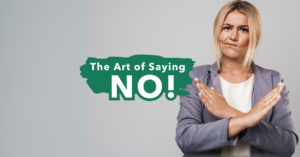I was struck by the story of Michael Johnson, a US Olympian in both the 200 and 400-meter dashes. He describes his approach to breaking world records as: “There are a lot of things you have to concentrate on in the 400, and two of them are opposites: aggression and relaxation.” (source: Paradoxical Thinking by Fletcher and Olwyler)
On the surface, it sounds blatantly wrong. Dig deeper, and it makes sense. Sprinters do need to be competitive and run as hard as they can. Yet they actually run faster when they are relaxed. Go figure!
I suspect you may have wondered how some things can seem illogical and true simultaneously. For example:
- Less is more.
- Slow down to go faster.
- You must let go to gain control.
- The more you know, the more you realize you don’t know.
- Freedom requires discipline.
Common business knowledge teaches us the “pick two approach.” It states that your product can ONLY compete on two of these three features: price, quality, or speed—never all three. You can offer lower-cost goods that are less expensive (think WalMart). You can bring to market high-quality goods at a big price point (Designer clothing). Yet the idea that you can produce high-quality products quickly and at a good price point is deemed unattainable.
Until it isn’t.
Innovative companies have found ways to do all three and have disrupted the market.
IKEA
- Speed: Ready-to-assemble furniture means customers can take it home the same day.
- Price: Mass production, flat-pack shipping, and cost-conscious design keep prices low.
- Quality: While not luxury-tier, IKEA products are known for good design, durability, and environmental sustainability at their price point.
Amazon
- Speed: Same-day or next-day delivery through Prime and a powerful logistics network.
- Price: Highly competitive pricing through third-party sellers and aggressive margin strategies.
- Quality: From top-reviewed items to trusted brands, Amazon provides quality through transparency (customer reviews, return policies) and convenience.
Costco
- Speed: Efficient store layout and bulk-buying simplicity = fewer trips, quicker shopping.
- Price: Known for rock-bottom prices on high-quality bulk goods and private label (Kirkland).
- Quality: High standards for what’s sold in stores, often outperforming name brands.
Toyota
- Speed: Streamlined manufacturing (lean production) and global distribution ensure timely delivery.
- Price: Competitive pricing, especially with models like Corolla and Camry.
- Quality: Legendary for reliability, safety, and longevity — consistently ranking high in quality reports.
This is exactly why understanding the power of paradox to drive innovation can be a compelling business advantage. Whenever we engage in binary, dualistic, or either-or thinking, we’ve boxed ourselves into a two-dimensional box. When you begin to work with paradox, you push yourself to test limits, think more creatively, and be original in a sea of sameness.
Chat GPT actually wrote an insightful quote about paradox and innovation:
When organizations embrace paradox, they stop seeking quick fixes and start cultivating generative solutions. This means making space for intuition and analysis, rest and productivity, feminine wisdom and masculine drive. Instead of suppressing conflict or difference, paradox teaches teams to mine it for insight. It empowers leaders to model wholeness — showing that vulnerability doesn’t weaken authority, and structure doesn’t stifle soul. In this space, creativity thrives not just as a department but as a culture. Paradox becomes not a problem to solve, but a doorway to deeper intelligence.
Here are two quotes that I love about paradox:
Clarissa Pinkola Estés (woman, author of Women Who Run With the Wolves)
“To be ourselves causes us to be exiled by many others and yet to comply with what others want causes us to be exiled from ourselves.”
Alan Watts (man, philosopher and writer)
“The more a thing tends to be permanent, the more it tends to be lifeless.”
And so, if you would like to be more innovative and creative, embrace the paradox. Strike “yes, but” with “yes, and”. Ask good questions, such as:
- What would it look like if this were easy?
- What are the opposites we are trying to choose between? What if we attempted to integrate them instead?
- What other models, outside our space, might we borrow, adapt, or learn from?
- What does nature teach us about this situation?
- Instead of defending our positions, what would happen if we integrated the goodness of the opposite point of view.
If you are intrigued by the idea of using paradox to open up your thinking, reach new insights, and foster innovation, you can download this one-page guide that will help you navigate complexity. (sample below)
Paradox Leadership Canvas: A One-Page Guide for Navigating Complexity and Sparking Creativity
Step 1: Name the Tension
Identify the Challenge
- What is the current decision, challenge, or dilemma?
- Where do we feel stuck between two opposing needs?
Write Both Sides:
- Side A: __________________________
- Side B: __________________________
Step 2: Explore the Both/And
Shift from Either/Or to Both/And Thinking
- What would it look like if we honored both sides?
- What assumptions might we be making that are limiting us?
Brainstorm Ideas:
- Idea 1: _______________________________________
- Idea 2: _______________________________________
- Idea 3: _______________________________________
Step 3: Find the Creative Opportunity
Discover the “Third Way”
- How could combining these tensions create a new advantage?
- Where does innovation live between the extremes?
Opportunity Statement: “If we integrate [Side A] and [Side B], we could create _____________.”
Step 4: Align Action with Paradox Wisdom
Commit to Both/And Action Steps
- How will we move forward holding both truths?
- What are 2-3 practical next steps?
Next Steps:
Step 5: Reflect and Refine
Embed the Learning
- What did we learn about ourselves and our leadership?
- Where else can we apply paradox thinking?
Key Insights:




